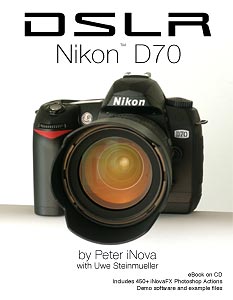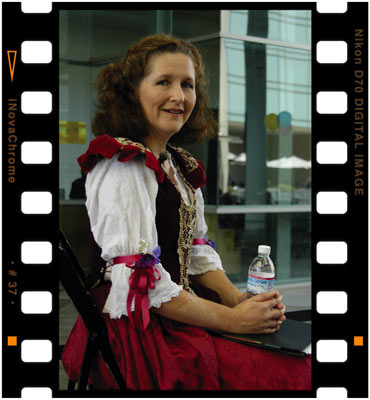Overview Far from being an entry-level camera, it is the anchor of the Nikon professional dSLR line. What makes it all the more interesting is its price; with the reach of photographic enthusiasts as well as committed professionals. With a D70 in your hands, the visual world has expanded and so have the number of questions you may ask: And more importantly, how do I sort through this maze in a logical, easy to approach, enjoyable voyage of discovery? You can set the D70 to full Auto Exposure and let Nikon sort it out, or take control and achieve spectacular results. Everybody wants different things. Some people want to know what the buttons do. For them, there's the camera manual, and it's very complete. Others want to know why things work the way they do. Some of that is in the manual, but in the eBook, those ideas are thick. Still others want to know when to do this and when to avoid that. Here the eBook delivers in high volume. Interactive Bookmarks and Thumbnails. It's an eBook, after all. Detailed images of other pages can be scrolled next to the page you're reading, allowing you to spot the contents of other pages. The unique look and layout of each page can easily be identified and jumped to quicker than flipping through many paper books. A sample page shows you how easy this is to view and navigate. Peppered liberally throughout the text are the interactive links. Some jump to a topic within, others fire up your Web Browser and bring you pages from all over the world of digital photography. Although a large number of links steer you to commercial suppliers, not a penny of advertising is accepted for links in the eBook. Where you go is where we think you'll find the best answer. Period. (Notice that we have no paid links on this site? No Google ads here. We feel that the best advice doesn't come from a consultant on someone else's payroll.) Filters On Board: The dust jacket reverses to become two types of tools for your photo sessions. One is a test chart for inclusion in the shot as a reference. It has gray, white, grayscale, and color patches that tell you if the color is off and give you a reference that works with the Photoshop filter software for putting it back together just right. The other side has the amazing glass-free color filter collection that work with any lens in any light. You white balance on these images and instantly turn your D70 into its own color filter set. Want a more magenta sunset? Use the last rays of sun as the light source on the right one of these filters and you'll have it. There are 12 of them. 12 different hues and detailed instructions on how to use them. Organization: Instead of one single file to load into your computer, the eBook is presented in two complete book versions: 2. The High Resolution version, with image quality about six times higher than typical web-distributed PDF files, is also available. It behaves identically to the Ultra Resolution version but the images are held at slightly lower resolution. For systems with lower memory or slower CPUs, this version includes all the Thumbnails and Bookmarks of the Ultra Res version and it moves faster through your computer. Image blow up is limited to 200% before you could begin to see the pixel structure of images, and for most images, that's plenty good enough. Renaissance water. Read the frame edges. Extras: Without question, D70 image quality, technical and ergonomic factors bring you to a new level in photography. You can see better, capture quicker and achieve more with this camera than with any compact digital you've ever held. And if you are coming from the film side of the world, get ready for electronic film that kicks sprocket holes into the past. Or brings them back as a graphic treatment to be applied at will. What this all means is that you are in electronic darkroom heaven, now. Big Photoshop is your main tool. Sure, you could use lesser editing products, but why? Do you put on a tux--and then wear sneakers to "save money"? With Photoshop 6, 7 and CS, you get to use Actions. Over 460 of these are included in the dSLR: D70 eBook--all originals that appear nowhere else--and they bring you an enormous range of techniques, variations and corrections. Correct things, tweak things, enhance things, interpret things, add things and take things to a new photographic universe with the highly respected iNovaFX Photoshop Actions--many of which are custom designed to the D70, your lens and your needs. Got barrel distortion? Who doesn't? Surely there must be a way of dealing with that. Straight lines or slight waves? Rollover to see it fixed and click to see the fixed image without the reference lines. Here's a sample. Most D70s are sold with the 18-70mm AF DX Nikkor lens and it creates a wide angle setting equal to a 27mm lens in 135 film terms. Great for wide images of architecture, right? Well, ALL lens designers are balancing the complex math of zoom scale, f-stop, spectral (color) focus and geometry. You want it wide, fast, sharp and linear, and to help the top three requirements, one must be compromised. In short, zoom lenses from every source contain a bit of barrel distortion. The top designs from Canon, Nikon, Zeiss, Tamron, Sigma and Tokina all show something barreling through their zoom range and the 18-70mm AF DX Nikkor controls barrel distortion much better than most since it is judiciously using aspheric elements and exotic glass. Perfect? No. In fact the barrel distortion is different in the corners compared to the center of the frame. I call this "M-Type" barrel distortion and no spherical correcting utility will fix it. See how it looks fine in the corners, but not in the middle? A very shallow "M". The same situation prevails in the Nikkor 12-24mm DX, the 24-120 VR Nikkor and the 28-200mm AF G Nikkor. But when you fire up the eBook, you can import the iBCD70 string of iNovaFX Photoshop Actions into your computer and perfect is just a click away for all of these lenses. Please note that these Actions only work with the full versions of Photoshop starting with V 6.0. We bring every linear area of the image back to tight linear tolerances so you don't have to explain to the chairman of the board why his building seems to have a slight wave across the roof. No need to hide the zoom lens when planning big architectural prints. The iNovaFX results achieve what mere optics cannot. Variations cover you at different settings over all the lenses listed above. Take this idea to its logical next step: Straighten out a fisheye image. Check that page here. Who would have believed that a fisheye lens could achieve such rectilinear results?f iNovaFX Actions create emotion, too. A picture is worth a thousand notes. Rollover for original. Want a complex image treatment that tugs at the heart strings of music lovers everywhere? Try one of the several iHalcyon Actions. Nostalgic photography (similar to the looks found in Sky Commander and the World of Tomorrow can be yours today. And each of these produces a multi-layer result, allowing you to tweak the final image to your taste. Want more color, less diffusion and lower contrast. Get ready to click. More importantly, the eBook pages are stuffed with interactive examples like these that animate right on the page. But in the eBook, the images are orders of magnitude bigger, sharper and less compressed. There's even a movie in the the How Do I... chapter showing how time-lapse images can be made from strings of frames. QuickTime for Mac or Windows will be needed to see that, but it's free from Apple. Special extra chapters from Uwe Steinmueller take you into the heart of Photoshop Layers and D70 RAW image conversion. dSLR: Nikon D70 brings you more, delivers gems of experience and information and takes your camera to the next level and the next. Q: How much does it cost? A: Like previous iNova eBooks, it is priced under $50. Q: Can I upgrade from prior eBooks? A: This is not an upgrade, it's a new title, but we have a special price for prior eBook owners of Nikon Coolpix or Sony eBooks. Contact the publisher by phone to order the DSLR: D70 eBook. Phone (310) 475 2988 (M-F 9-5 Pacific Time) or FAX: (310) 475 9486 and have your original disk handy. You'll need the original serial number. Q: How big is it? A: Stats show 446 pages (letter format and page size for printing), over 1100 images, over 420 InfoBites in the Camera System Chapter alone, over 460 iNovaFX Photoshop Actions plus demo software, sample images, tutorial images and the color filter case that creates 12 "in-camera" color tint filters for you in the field and under any lighting. About that last item: You're not going to believe how amazingly cool Nikon has made this camera until you start using the in-camera color filters. Eleven chapters plus interactive Appendix, Index and Gallery of D70 images. Includes Adobe PDF Readers for Mac OSX and Windows plus demo software from Adobe, PhotoRescue and others. Order it here.
 The Nikon D70 is an amazing camera. It shoots a 6 megapixel image--detailed enough for tabloid-sized prints--and it inherits nearly every feature, ability and technology Nikon has evolved in their other digital cameras.
The Nikon D70 is an amazing camera. It shoots a 6 megapixel image--detailed enough for tabloid-sized prints--and it inherits nearly every feature, ability and technology Nikon has evolved in their other digital cameras.
 How does it work?
How does it work?
 Give me what I want to know.
Give me what I want to know. ![]() InfoBites are factoids. Things you should know because they affect your approach and decision process. There are well over four hundred of these in the Camera System Operations Chapter Four alone. And you can search the text to find any of them with Adobe Reader (included for both Windows and Macintosh). Each calls your eye with the InfoBite symbol at the head of the paragraph.
InfoBites are factoids. Things you should know because they affect your approach and decision process. There are well over four hundred of these in the Camera System Operations Chapter Four alone. And you can search the text to find any of them with Adobe Reader (included for both Windows and Macintosh). Each calls your eye with the InfoBite symbol at the head of the paragraph.![]() InfoBites: ideas to remember because they reveal a technique, a factoid, a cool bit of knowledge, or a secret you should know.
InfoBites: ideas to remember because they reveal a technique, a factoid, a cool bit of knowledge, or a secret you should know.
 1. The Ultra Resolution version with the maximum image quality heads the list. This is the version that allows 400+% blow-ups on screen without seeing pixels. It's far more detail than you would need to print out pages, but you can do that if you wish. The big advantage here is that you can peer DEEPLY into images at 400% enlargement in your Adobe PDF Viewer and study the structure and sub-structure of images without compromise. Is it as good as a printed book? No. It's about 250% better than a printed image. No dot screen here.
1. The Ultra Resolution version with the maximum image quality heads the list. This is the version that allows 400+% blow-ups on screen without seeing pixels. It's far more detail than you would need to print out pages, but you can do that if you wish. The big advantage here is that you can peer DEEPLY into images at 400% enlargement in your Adobe PDF Viewer and study the structure and sub-structure of images without compromise. Is it as good as a printed book? No. It's about 250% better than a printed image. No dot screen here.
